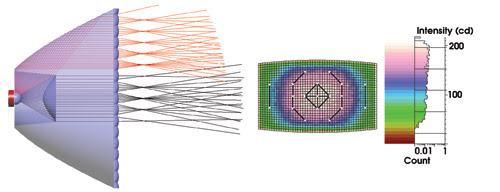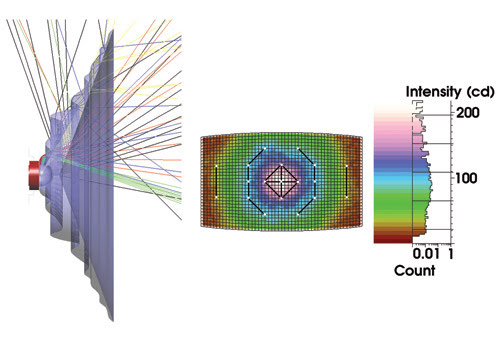Software eases the burden of complex design while producing thinner, more efficient and less expensive optics.
Michael W. Zollers, Optical Research Associates
Headlights and taillights have been on automobiles for about as long as automobiles have had rubber tires, and filament lamps have provided their light for just about as long. The size and shape of the filament have kept the optical designs of these lamps relatively unchanged, with breakthroughs occurring primarily in the materials used to make the reflectors and the lenses. The next big change, however, is a move away from the filament and toward LEDs in all automotive lighting.
LED lamps have been on vehicles for about a decade, and most of today’s designs use scaled-down versions of the same type of optics found in filament lamps. The reason for this is twofold: First, the design and manufacture of these optical systems are well understood; second, using any other type of optical system introduces additional costs and increased manufacturing risks.
When working with LEDs, designers must balance cost versus efficiency. More efficient LED optical systems are more expensive to manufacture because they tend to be thick. A designer could choose to use several low-power LEDs, but a lamp that is legal — meaning that it will pass US and European standards for intensity — requires a lot of them, which raises the cost. Therefore, the number of LEDs must be kept low, but this requires an optically efficient design. In most cases, the old-fashioned filament lamp will be cheaper. The advantage of LEDs is mostly electrical — a 1-W LED versus a 27-W filament bulb — and styling.
Efficient designs tend to place an extra burden on the designer or on the manufacturer. Illumination software simplifies the design process. But an optical system that has more than 50 percent optical efficiency will likely require a thick solid piece of plastic that uses total internal reflection instead of low-reflectance, metallized coatings to collect the light. The thickness of the optics causes manufacturing issues, although some companies specialize in thick, optical-grade, injection-molded plastic parts, which can ease the onus on the manufacturer.
Thin and efficient optical designs are easier to manufacture but have been difficult to design — until now, with the development of automatic optimization routines in illumination design software that make improvements without user intervention. The combination of virtual prototyping and optimization in the software provides a powerful tool for creating better-performing designs in less time. By allowing the software to vary the geometry over the design space, shapes that were never before considered may be found to work well.
Consider the following design for a taillight that uses a single LED. Several LEDs on the market have enough flux and luminance to be used in this design. For this example, the Lumileds K2 in red-orange was chosen. Using revolved Bezier profiles and a lenslet array, a 50 percent efficient design could be created by hand in a few hours (Figure 1). The problem is that the design is more than 2 in. thick. This piece would not mold well in most high-speed, injection-molded-plastic processes. If it were less than 10 mm thick, it could be manufactured more easily and inexpensively.

Figure 1. This thick single LED taillight design is legal for use in the US.
The design in Figure 2 was created using free-form spline surfaces. The thickness is a maximum of about 7.5 and an average of about 5 mm. To make this by hand, a designer would have to fine-tune more than 25 parameters. With optimization, the designer could tell the software which parameters to vary, establish constraints that the system must meet and then optimize it to achieve a certain goal, which, in this case, is a legal lamp. Depending on the complexity of the system, optimization can take a few hours or a few days; more complex systems typically take longer. Even so, this is time that the designer can spend working on other projects or optimizing the same system with a different design form.

Figure 2. A design of a thin single-LED taillight also meets US standards.
The level of design complexity is often inversely proportional to the thickness of the optics. This is the case for most external automotive lamp designs. As LEDs continue to supplant filament sources on other automotive lamps, the need for high-efficiency, low-cost designs will continue to challenge illumination designers. The combination of robust optimization algorithms with illumination design software will be the enabling technology that levels the playing field and allows LEDs to accelerate their integration into the automotive market.
Meet the author
Michael W. Zollers is an optical engineer with Optical Research Associates in Pasadena, Calif.; e-mail: [email protected].